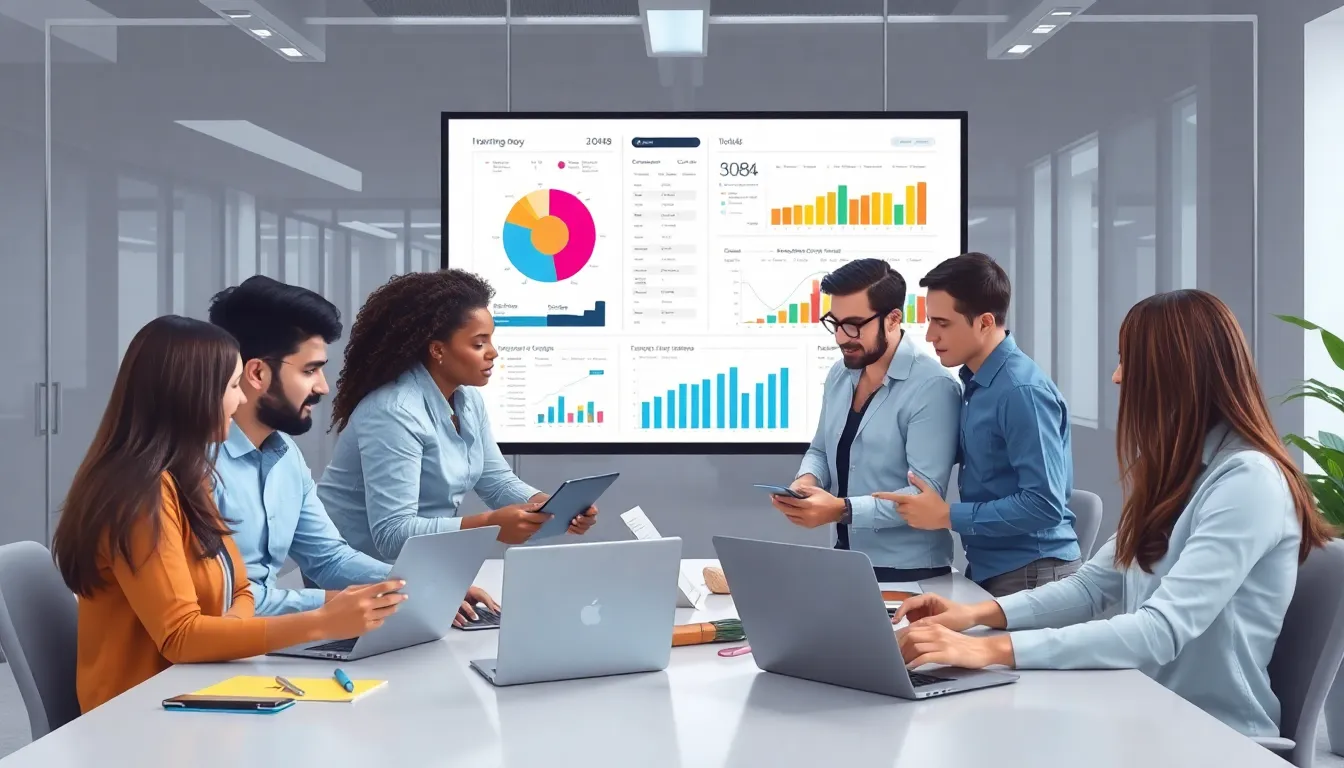In a world where everyone’s glued to their phones, marketing automation for mobile apps is the secret sauce that can make an app stand out. Picture this: you’ve got a fantastic app, but without the right marketing, it’s like throwing a party and forgetting to send out invitations. No one’s showing up!
Table of Contents
ToggleUnderstanding Marketing Automation for Mobile Apps
Marketing automation plays a critical role in promoting mobile apps in a competitive landscape. It streamlines marketing tasks, enabling developers to focus on app quality and user experience.
Definition of Marketing Automation
Marketing automation refers to using software to automate repetitive marketing tasks. These tasks include email campaigns, social media posting, and ad management. By automating these processes, businesses can target users with relevant content at the right time. Automation enhances operational efficiency, allowing teams to focus on strategy instead of manual execution.
Importance for Mobile Apps
Mobile apps thrive on effective marketing strategies. Marketing automation boosts user engagement through personalized experiences. Automated messaging reaches users based on behaviors and preferences. This approach not only increases retention rates but also drives conversions. According to a report, mobile apps that utilize automation see 50% higher engagement compared to those that don’t. Emphasizing automation helps developers stand out, ensuring their apps gain visibility and attract users in a crowded market.
Key Features of Marketing Automation Tools

Marketing automation tools for mobile apps offer essential features that enhance marketing efforts and drive user engagement. These tools streamline processes, making it easier for developers to implement effective marketing strategies.
User Segmentation
User segmentation allows marketers to divide their audience into distinct groups based on behaviors, demographics, or preferences. By targeting specific segments, developers send personalized messages that resonate with individual users. Segmentation improves engagement rates as users receive notifications tailored to their interests. For instance, an app can identify heavy users and offer them exclusive rewards, while less active users receive motivation to return. This tailored messaging fosters a deeper connection with the audience, ultimately increasing retention rates.
Campaign Management
Campaign management tools simplify the planning and execution of marketing initiatives. They enable marketers to set up automated workflows, schedule campaigns, and execute targeted outreach across multiple channels. Effective management ensures timely promotions reach users, maximizing impact. Marketers can run A/B tests to compare campaign performance and refine strategies based on insights. Automation eliminates manual tasks, allowing teams to focus on creative content and messaging. An organized system helps maintain consistency across campaigns, contributing to a cohesive brand presence.
Analytics and Reporting
Analytics and reporting features provide valuable insights into user behavior and campaign performance. These tools track key metrics such as open rates, click-through rates, and conversion rates, helping marketers measure success. Analyzing data allows for informed decision-making and strategy adjustments based on real-time feedback. Comprehensive reports reveal patterns and trends, enabling developers to understand user preferences better. With this data-driven approach, businesses identify opportunities for optimization and growth, ensuring their marketing efforts align with user needs.
Best Practices for Marketing Automation
Effective marketing automation enhances user engagement and drives conversions. Implementing best practices ensures optimal results and maximizes the app’s potential.
Personalization Strategies
Personalization strategies play a crucial role in marketing automation. Segmenting users based on specific behaviors, demographics, or preferences allows for tailored messaging. Engaging content resonates more with users, enhancing the user experience. Utilizing dynamic content in emails or notifications captures user attention and encourages interaction. By adapting messages to user profiles, marketers can improve engagement rates significantly. Studies show that personalized messages can lead to conversion rates that are six times higher than non-personalized alternatives.
Timing and Frequency of Communications
Timing and frequency significantly impact the success of marketing campaigns. Sending communications at optimal times helps maximize user engagement and responses. Analyzing user activity patterns reveals when users prefer receiving messages. Automated scheduling ensures timely delivery, keeping the app fresh in users’ minds. Avoid over-communicating, as excessive messages can lead to user fatigue. Best practices suggest sending messages no more than two to three times a week, and testing variations helps determine the most effective frequency.
Popular Tools for Marketing Automation
Numerous tools exist to simplify marketing automation for mobile apps, ensuring effective engagement with users. Successful marketers utilize these platforms to optimize their strategies and enhance app visibility.
Overview of Leading Platforms
Several leading platforms provide robust marketing automation solutions tailored for mobile apps. HubSpot offers a comprehensive suite for inbound marketing, supporting email campaigns and social media management. Growbots automates lead generation with intelligent targeting, facilitating user acquisition. Mailchimp focuses on email marketing automation, allowing personalized outreach and analytics. ActiveCampaign stands out with its customer experience automation features, streamlining workflows and engagement efforts. Each of these platforms equips marketers with essential tools to enhance user interaction and retention.
Comparison of Features
Feature sets vary among marketing automation tools, but certain aspects stand out in facilitating app marketing. User segmentation capabilities enable targeted messaging based on demographics or behaviors, enhancing overall effectiveness. Analytics and reporting functions provide valuable insights, allowing marketers to track campaign success and optimize strategies. Integration options determine how well these tools connect with other software, ensuring a seamless data flow. Automated workflows streamline marketing tasks while maintaining a personal touch. Evaluating these features helps marketers select the right tool for their specific needs, ultimately improving user satisfaction and app performance.
Measuring Success in Marketing Automation
Measuring success in marketing automation involves tracking crucial metrics that align with business objectives. These metrics provide actionable insights into the effectiveness of engagement strategies.
Key Performance Indicators (KPIs)
Common KPIs for mobile app marketing automation include user acquisition cost, customer lifetime value, and conversion rates. User acquisition cost indicates how much is spent to acquire a new user. Customer lifetime value reflects the total revenue generated from a user over their engagement lifecycle. Tracking conversion rates reveals how effectively marketing initiatives turn prospects into active users. Optimizing campaigns based on these performance indicators drives better results. Regularly analyzing these metrics ensures that marketing efforts remain on target and effective, helping businesses adapt strategies as needed to maximize ROI.
Analyzing User Engagement and Retention
User engagement and retention metrics offer insights into app performance and user satisfaction. Active users over specific periods highlight how frequently users interact with the app. Monitoring retention rates shows the percentage of users who return after their first visit and can signify the effectiveness of personalization efforts. Collecting feedback through in-app surveys can uncover user perceptions and preferences, enhancing the overall experience. Utilizing automated reporting tools allows marketers to track engagement trends in real time. Keeping an eye on these metrics not only fosters informed decision-making but also helps maintain a loyal user base, ultimately leading to increased revenue.
Marketing automation is essential for mobile app success in today’s competitive environment. By streamlining marketing tasks and enabling personalized user experiences, it helps developers focus on what truly matters—app quality and user satisfaction. The right automation tools enhance engagement through targeted messaging and data-driven insights, driving conversions and improving retention rates.
Implementing best practices in automation ensures marketers connect with users effectively while avoiding fatigue. With the right strategies and tools, mobile apps can stand out, attract users, and thrive in a crowded marketplace. As businesses continue to embrace automation, they’ll find it’s not just a trend but a vital component of their marketing strategy.




